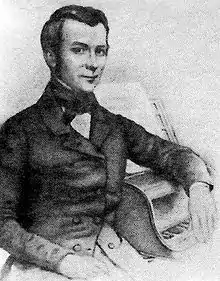Aleksander Gurilyov
Aleksander L'vovich Gurilyov (Russian:Александр Львович Гурилёв) (3 September [O.S. 22 August] 1803 – 11 September [O.S. 30 August] 1858) was a composer, pianist and music teacher who largely enriched the traditional romantic Russian repertoire through his solid technical accomplishments. He composed well over two hundred musical pieces imbued with romantic, sentimental moods and subtle lyricism which enjoyed great success in Russia. His numerous morceaux in his dramatic declamatory style, pre-date the creative works of Dargomyzhsky, Mussorgsky and Tchaikovsky.

Biography
The young Aleksander was raised in the rich musical environment of Count Vladimir Orlov's country estate Otrada, near Moscow.[1] He was taught violin by his father, Lev Gurilyov,[2] a serf musician and kapellmeister in the orchestra of the Orlovs. Together with his children, he took lessons in piano playing from Russian-based pianist of Irish origin John Field and later studied music theory under the guidance of Iosif Genishta.[2][3]
In 1831, he was freed after the death of his father's owner and moved to Moscow, where he soon became known as a composer of folk music, pianist, and teacher.[2] Having become acquainted with the representatives of the Moscow intelligentsia - artists and writers, Gurilyov wrote songs based on poems by Grekov, Aleksey Koltsov, Makarova, and rapidly acquired popularity. Some of his compositions were published by well-known publishers in music magazines. Of great importance for him was his friendship with the composer Alexander Egorovich Varlamov, the warmth from whom in many ways brightened up his lonely life.[3] Despite the success of his works, Gurilyov spent most of his life in poverty, earning his life as a private teacher and correcting musical notes. In his last years, he was paralyzed and suffered from mental illness, which eventually became the cause of his death in Moscow in 1858.[3]
Musical works
Alexander Gurilyov was a popular composer of Russian vocal music very popular in the 1820s and 1830s.[4] He wrote over 200 pieces, of which 50 are either folk pieces or were written in this style.[5] Many of them are sung by the Don Cossack Choir and other renowned vocal companies.[6][7]
- Mother, My Dear
- The Gray-Winged Swallow Hovers
- The Bell Is Ringing Monotonously
- Little Sarafan (words by Aleksandr Polezhayev)
- La Fontaine
- Song Of The Coachman
- The Lovely Bird Has Flown
- The Swallow Circles
- Avert Your Eyes, Don't Look!
- I Told You When We Parted
- The Maiden's Sorrow
- Monotonously Rings the Little Bell
- You Can Not Understand My Grief
- A Toy Heart (words by Eduard Ivanovich Guber)
- The Prayer (words by Mikhail Lermontov)
- You Do Not Sing, Nightingale (words by Aleksey Koltsov)
- A Girl's Sadness (words by Aleksey Koltsov)
- Separation (At the Dawn of Hazy Youth)
- Variations on Do Not Awaken Her at Dawn of Alexander Varlamov
- Do Not Torture Me, My Darling from the opera Ivan Susanin of Mikhail Ivanovich Glinka
References
- Stavrou, Theofanis George (1983). Art and culture in nineteenth-century Russia. Indiana University Press. p. 74. ISBN 025-331-051-2.
- Prokhorov, Aleksandr Mikhailovich (1982). Great Soviet encyclopedia, Volume 7. New York: Macmillan. p. 488. 60879620
- St. Petersburg City Children's Music School im.S.S.Lyahovitskoy. "Александр Львович Гурилёв". GDMSH. Archived from the original on 11 September 2013. Retrieved 22 July 2012.
- Kahn, Andrew (2006). The Cambridge Companion to Pushkin. Cambridge University Press. p. 164. ISBN 052-184-367-7.
- Vodarsky-Shiraeff, Alexandria (1969). Russian composers and musicians: a biographical dictionary. New York: Greenwood Press. p. 52. ISBN 0837125618.
- Hodge, Thomas P. (1999). A Double Garland: Poetry and Art-Song in Early-Nineteenth-Century Russia. Northwestern University Press. p. 273. ISBN 081-011-684-7.
- Tumanina, N V (1957). Istoriia russkoi muzyki (in Russian). Moscow: Gosud. Muzykalnoe Izd-vo. pp. 199–203. OCLC 7311720.